Flip Lesson 7 - Epigenetics
1/37
There's no tags or description
Looks like no tags are added yet.
Name | Mastery | Learn | Test | Matching | Spaced |
|---|
No study sessions yet.
38 Terms
Epigenetics
Heritable /Enduring change in gene expression not related to variation in nucleotide sequence
May be enduring in the sense of:
• the life of a long lived cell
• retained from mother to daughter cell
• retained from parent to offspring
Epigenetics relate to DNA factors other than nucleotide sequence that impact on gene expression
DNA methylation does what to chromatin, cytosines & histones of a gene
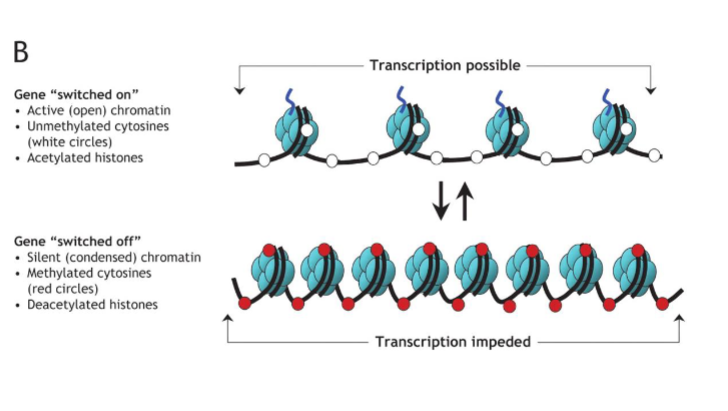
Bialleleic vs. Monoallelic Expression
Biallelic expression – both alleles expressed
Monoallelic expression – only one of the two alleles is expressed
Imprinting involves Bialleleic/Monoallelic Expression
Monoallelic Expression
How does expression in imprinting work
The expression of genes in a parent-of-origin-specific manner
Only the allele inherited from a specific parent (either the maternal or paternal allele) is expressed
What % of human genes are imprinted
<1%
What change in DNA is imprinting related to? (amination/acetylation/methylation)
Imprinting is related to Methylation of Cytosines (in promoter) & histones
Does imprinting involve modification of DNA & a nucleotide sequence change
Modification of DNA but not nucleotide sequence change
Is imprinting temporary/enduring/permanent
Enduring
Give an example of something that is imprinted
Insulin Like Growth Factor 2 (IGF2)
Which allele is normally expressed for Insulin Like Growth Factor 2 (IGF2) (maternal/paternal)
Paternal
The Maternal Allele is “Imprinted” (shut down)
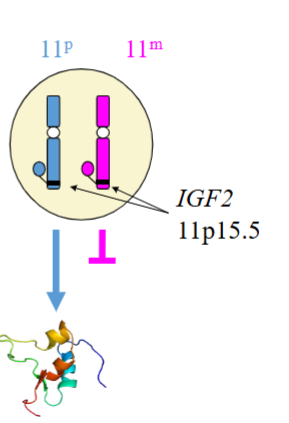
Sally has an allele of Insulin Like Growth Factor 2 (IGF2) from Don – which works
She has an allele of Insulin Like Growth Factor 2 from Betty that is switched off (imprinted)
If Sally has a child, which allele of the IGF2 gene will work?
Trick Question - In any oocytes that Sally (the mother) makes, whichever version of the allele is present will be switched off
What happens to imprints in the germline & in the sperm & the egg?
Imprints are erased in the Germ-line and re-established in gametes.
In the sperm all imprints are erased and rewritten with the paternal pattern, even the alleles that came from mum
In the ova all imprints are erased and rewritten with the maternal pattern, even the alleles that came from dad
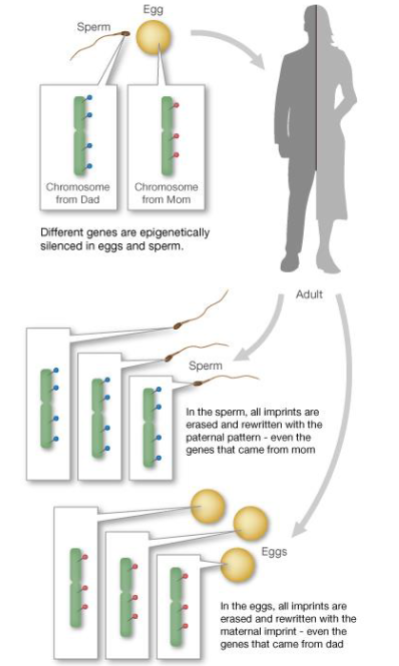
Imprinting genes are more/less vulnerable to mutation
more - dominant mutations
Symptoms of angelman syndrome
• Small
• Profound intellectual disability
• (unable to speak and with particular behaviour pattern)
Symptoms of Prader-Willi Syndromes
• Floppy babies (hypotonia)
• Intellectual/cognitive disability
• Uncontrollable appetite (obesity)
• Hypogonadism in males
Prevalence of Prader-Willi Syndromes
1:22,000
What time of genetic mutation is associated with Angelman & Prader Willi
Both associated with a de novo deletion on long arm of Chr 15 (15q11-q13)
What is genetically different about Angelman & Prader Willi
• Deletion from paternal Chr 15 = Prader Willi
• Deletion from maternal Chr 15 = Angelman
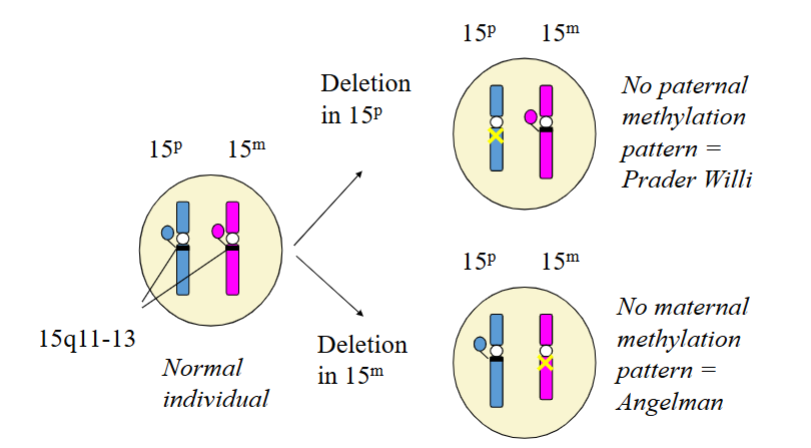
Explain how Uniparental Disomy (UPD) can also cause these genetic disorders
UPD occurs when 2 copies of a Chr come from the same parent
Therefore both will have either maternal or paternal pattern of methylation
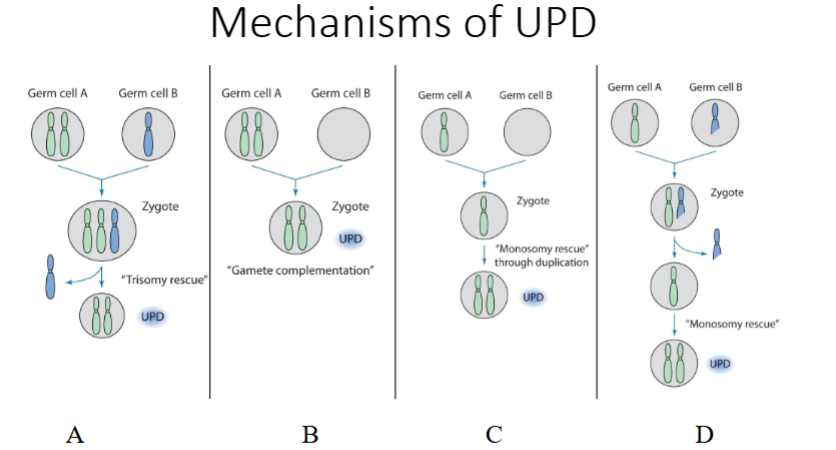
What is X-Inactivation
The random transcriptional silencing of all but one X chromosome in females (Random inactivation of paternal or maternal X)
At what point in development does X inactivation occur
Early in Embryonic Development (totipotent cells) both X chromosomes are active
With differentiation to pluripotent cells random X inactivation (late blastocyst stage)
Inactivated X condensed on periphery of nucleus (Barr body)
Is X-Inactivation heritable
The inactivation is retained through all subsequent mitosis → all daughter cells
But not retained across generations! - Not heritable from parent to child
How does retention of the x inactivation work
XIST gene in the X inactivation centre (Xic) produces Xist RNA transcript that covers the X chromosome to be inactivated (Xi).
Subsequent DNA methylation (epigenetic) then makes this silencing permanent in all daughter cells.
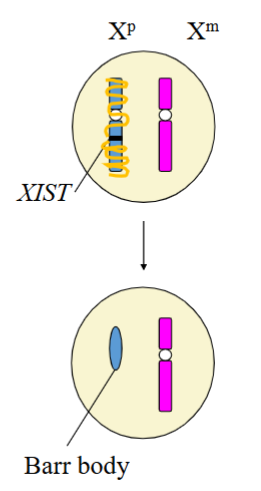
What is Skewed X-inactivation
Ratio of inactivated maternal X to paternal X should be equal (random), but is uneven (skewed) in 10-15% of women
What explains the reason why there is such variability in the expression of X-linked disorders.
Preferential inactivation of the “abnormal” X in heterozygotes is the reason why there is such variability in the expression of X-linked disorders
Can skewness effect the severity of a disease
If the diseased X-linked allele does not cause selection, the extent of the primary stochastic skewing can influence the severity of the disease.
Skewed X-inactivation common in cases of severe X mutation or structural anomaly
Rett Syndrome is an x linked recessive/dominant disorder
dominant
Rett Syndrome is usually caused by mutations in what gene
MECP2
Rett Syndrome affects who
Affects young girls from 6-18 months
Symptoms of Rett syndrome
• Brain/cognitive function impaired
• Hand coordination lost (hand-wringing)
• Seizures and breathing problems
Rett syndrome has a substantial phenotypic variability which may be influenced by what
Skewed X-inactivation
Is a higher/lower % skew more common
Low - Skewing >80% is rare
Duchenne Muscular Dystrophy genetic mutation
(Xp21.2)
Duchenne Muscular Dystrophy presents as what in men
• Muscle fibre weakness that presents in childhood
• Difficulty walking and rising (Gower manoeuvre)
• Wheelchair by teens
• Respiratory weakness
• Mild cognitive impairment
• Cardiomyopathy (ventricular remodelling)
How do heterozygous women with the (Xp21.2) mutation present
Only mild cardiomyopathy
Increased CK and muscle weakness
Generally don’t present with DMD - Those who do may have skewed X-inactivation
Epigenetics relate to DNA factors other than nucleotide sequence that impact on gene expression, primarily what process in what structures
methylation of CpG dinucleotides
For imprinted genes, the inheritance of what alleles is required for normal development.
For imprinted genes, the inheritance of maternal and paternal alleles is required for normal development.